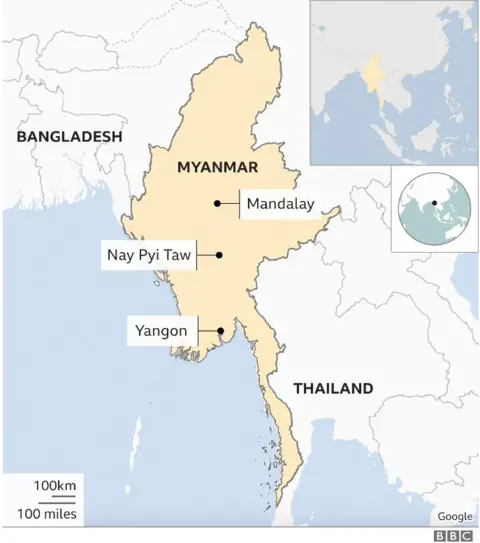Myanmar coup: Mass protests defy military and gridlock Yangon
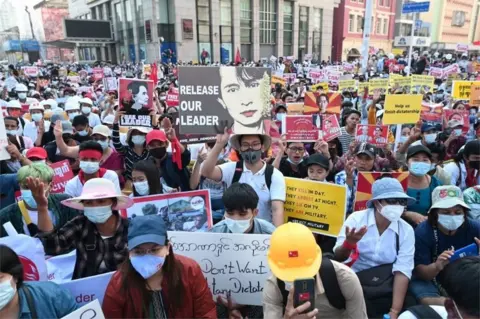 Reuters
ReutersHundreds of thousands of people have protested across Myanmar, staging some of the biggest anti-military rallies since the 1 February coup.
Drivers in Yangon staged a break-down protest, blocking key roads as loosely-organised civil disobedience grew.
In Mandalay, security forces fired shots near the railway station. At least one injury was reported.
Demonstrators are demanding the release of Aung San Suu Kyi and other elected civilian leaders following the coup.
A day earlier Ms Suu Kyi had been handed a second criminal charge. The military repeated its promise to hold fresh elections and relinquish power, though many protesters remain sceptical.
The developments came after the UN special rapporteur for Myanmar, also known as Burma, warned of potential violence by the military.
Ms Suu Kyi's lawyer told the BBC on Wednesday that he has had no direct contact with her.
Khin Maung Zaw, a veteran human rights lawyer, said his colleagues standing outside Ms Suu Kyi's court appearance detected "no sign of distress or health defects" in her voice.
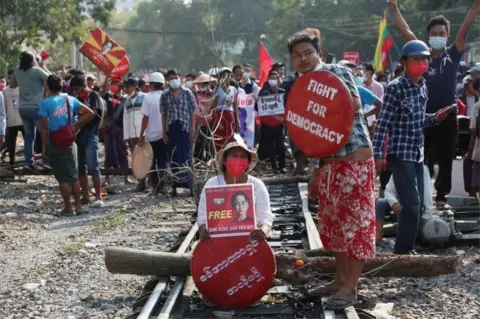 EPA
EPAThere were no reports of major trouble on Wednesday, but footage on social media showed several rounds fired by security forces near Mandalay railway station. It was not clear whether live ammunition was used.
Reports say protesters had been trying to prevent an army supply train from leaving. Railway workers said they were forced at gunpoint to drive the trains.
Protests took place in a number of other cities and towns. In the capital, Nay Pyi Taw, engineers, doctors and teachers joined forces to show defiance against the military.
'Road blocking day'
Wednesday's rallies nearly paralysed traffic in central Yangon (Rangoon).
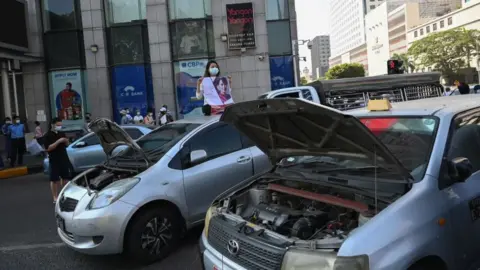 Getty Images
Getty ImagesA campaign on social media calling for protesters to deliberately block roads in the country's main city started gaining traction early on Wednesday. Its aim was apparently to stop civil servants from going to work and hinder the movements of security forces.
Dubbed "Road Blocking Day", it saw many posting pictures online of vehicles with raised bonnets and boots parked across key roads, making the streets impassable to traffic. A BBC Burmese reporter saw a number of public buses stop and block junctions in Yangon.
The protest is the latest in a mounting civil disobedience movement, which has also seen strikes by doctors and teachers, and boycotts of products and services owned by the military. The aim is to cripple the functions of government and undermine the new regime's legitimacy.
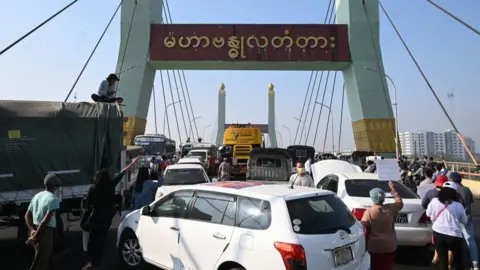 Getty Images
Getty ImagesBut one activist criticised the road blockages, saying they were holding up protesters heading to central Yangon.
"Stop the 'broken-down car' and help the protesters get to Sule as soon as possible," said activist Maung Saung Kha according to a Reuters report.
About 100,000 people flooded the Sule area on Wednesday, according to estimates by BBC Burmese reporters. Another similarly huge crowd gathered at Hledan near Yangon University. There were smaller protests near the Central Bank, the US embassy and the UN office.
Demonstrators have taken to the streets almost every day for the past fortnight, and these were some of the biggest protests since the coup, our reporters say.
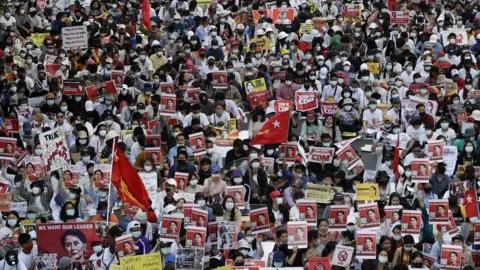 EPA
EPA"Let's gather in millions to take down dictators," Khin Sandar, an activist, had posted on Facebook.
"Let's march en masse [and] show our force against the coup government that has destroyed... the future of our country."
The UN Special Rapporteur on the situation of human rights in Myanmar, Tom Andrews, had warned of "potential for violence on a greater scale" on Tuesday, adding that additional soldiers had been deployed in cities where protests were planned.
"I am terrified that given the confluence of these two developments - planned mass protests and troops converging - we could be on the precipice of the military committing even greater crimes against the people of Myanmar."
The military authorities have promised to be patient in dealing with the protests - but that promise is widely distrusted, says BBC South East Asia correspondent Jonathan Head.
 EPA
EPAWhat's the background to all of this?
Myanmar's military seized control on 1 February, following a general election which Ms Suu Kyi's NLD party won by a landslide.
It claimed that the NLD had won through fraud, and demanded a rerun of the vote - despite the electoral commission saying there was no evidence to support these claims.
Power has now been handed over to commander-in-chief Min Aung Hlaing, and Ms Suu Kyi is under house arrest.
She was earlier charged with possessing illegal walkie-talkies, and has now been accused of violating the Natural Disaster Law, though the details of this second charge are unclear.
Protesters are demanding the release of Ms Suu Kyi and other key NLD members. These are the largest demonstrations in Myanmar since the so-called Saffron Revolution in 2007.
But clashes have taken place between security officers and protesters, and police have used tear gas and rubber bullets to disperse crowds.
The military has also been regularly blocking the internet in a bid to stifle dissent.

Myanmar - the basics
- Myanmar, also known as Burma, was long considered a pariah state while under the rule of an oppressive military junta from 1962 to 2011
- A gradual liberalisation began in 2010, leading to free elections in 2015 and the installation of a government led by veteran opposition leader Aung San Suu Kyi the following year
- In 2017, Myanmar's army responded to attacks on police by Rohingya militants with a deadly crackdown, driving more than half a million Rohingya Muslims across the border into Bangladesh in what the UN later called a "textbook example of ethnic cleansing"
- Aung San Suu Kyi and her government were overthrown in an army coup on 1 February following a landslide NLD win in November's elections

